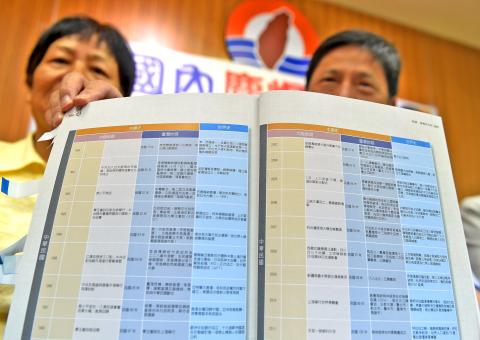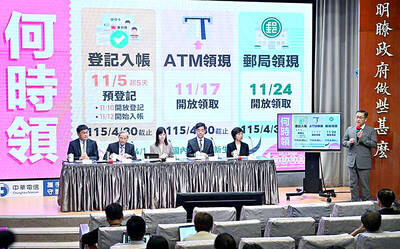The Taiwan Solidarity Union (TSU) caucus yesterday urged teachers not to use the new version of high-school social studies textbooks approved by the National Academy for Educational Research (NAER), which it said contain distorted and unsubstantiated historical information and aim to instill a China-centric mindset in young Taiwanese.
“The Ministry of Education has claimed that it was only responsible for reviewing high-school curricula and that it was up to textbook publishers to decide the content of the books they print,” TSU caucus whip Lai Chen-chang (賴振昌) told a news conference in Taipei.
However, Lai said that since the new curriculum has been “painted red,” most of the publishers have fallen in line, printing textbooks that do not conform to historical facts.

Photo: Chien Jung-fong, Taipei Times
Singling out the Shi Ji Cultural Publishing Co (史記文化事業), Lai said that the company combined the histories of Taiwan and China into what it called “national history,” which also included historical events that occurred during the Japanese colonial era.
“Shi Ji’s proprietor, Cheng Chih-shen (鄭旗生), doubles as the executive officer of the pro-unification Chinese Integration Association, while one of the firm’s textbook compilation committee members, Hao Ming-huang (邵銘煌), is the former director of the Chinese Nationalist Party’s [KMT] history department. Both men are considered ‘deep-blue’ diehards,” Lai said.
Lai said the publisher’s history textbook used the controversial term “returning to the embrace of the motherland” twice.
The book suggests that former president Lee Teng-hui’s (李登輝) formulation of the “two states theory” in 1999 hindered cross-strait negotiations, and the “one side, one country” model proposed by Lee’s successor, Chen Shui-bian (陳水扁), had destabilized Taiwan-US relations, Lai said.
The book has two full pages on the so-called “1992 consensus” embraced by President Ma Ying-jeou (馬英九) and also praises the Economic Cooperation Framework Agreement for elevating cross-strait exchanges to the next level. Lai said.
The “1992 consensus” refers to a tacit understanding that the KMT says was reached with Beijing that both sides agree that there is only “one China,” with each side having its own interpretations of what China is. Former KMT lawmaker (蘇起) said in 2006 that he had made up the term in 2000, when he was head of the Mainland Affairs Council.
“This is not a school textbook, but rather propaganda material designed to promote the KMT’s history and cross-strait unification,” Lai said, calling on high-school teachers not to use the new editions of book.
TSU Legislator Chou Ni-an (周倪安) said the lack of references in the books to democracy activist Deng Nan-jung (鄭南榕), the 228 Incident and the 1979 Kaohsiung Incident underscored the curriculum review team’s aim to cover up the former KMT regime’s disregard for human rights by creating the impression that the government had attached great importance to the issue.
“We as Taiwanese must stand up against the government’s brainwashing scheme and safeguard true human rights and democracy,” Chou said.

People can preregister to receive their NT$10,000 (US$325) cash distributed from the central government on Nov. 5 after President William Lai (賴清德) yesterday signed the Special Budget for Strengthening Economic, Social and National Security Resilience, the Executive Yuan told a news conference last night. The special budget, passed by the Legislative Yuan on Friday last week with a cash handout budget of NT$236 billion, was officially submitted to the Executive Yuan and the Presidential Office yesterday afternoon. People can register through the official Web site at https://10000.gov.tw to have the funds deposited into their bank accounts, withdraw the funds at automated teller

PEACE AND STABILITY: Maintaining the cross-strait ‘status quo’ has long been the government’s position, the Ministry of Foreign Affairs said Taiwan is committed to maintaining the cross-strait “status quo” and seeks no escalation of tensions, the Ministry of Foreign Affairs (MOFA) said yesterday, rebutting a Time magazine opinion piece that described President William Lai (賴清德) as a “reckless leader.” The article, titled “The US Must Beware of Taiwan’s Reckless Leader,” was written by Lyle Goldstein, director of the Asia Program at the Washington-based Defense Priorities think tank. Goldstein wrote that Taiwan is “the world’s most dangerous flashpoint” amid ongoing conflicts in the Middle East and Russia’s invasion of Ukraine. He said that the situation in the Taiwan Strait has become less stable

CONCESSION: A Shin Kong official said that the firm was ‘willing to contribute’ to the nation, as the move would enable Nvidia Crop to build its headquarters in Taiwan Shin Kong Life Insurance Co (新光人壽) yesterday said it would relinquish land-use rights, or known as surface rights, for two plots in Taipei’s Beitou District (北投), paving the way for Nvidia Corp to expand its office footprint in Taiwan. The insurer said it made the decision “in the interest of the nation’s greater good” and would not seek compensation from taxpayers for potential future losses, calling the move a gesture to resolve a months-long impasse among the insurer, the Taipei City Government and the US chip giant. “The decision was made on the condition that the Taipei City Government reimburses the related

FRESH LOOK: A committee would gather expert and public input on the themes and visual motifs that would appear on the notes, the central bank governor said The central bank has launched a comprehensive redesign of New Taiwan dollar banknotes to enhance anti-counterfeiting measures, improve accessibility and align the bills with global sustainability standards, Governor Yang Chin-long (楊金龍) told a meeting of the legislature’s Finance Committee yesterday. The overhaul would affect all five denominations — NT$100, NT$200, NT$500, NT$1,000 and NT$2,000 notes — but not coins, Yang said. It would be the first major update to the banknotes in 24 years, as the current series, introduced in 2001, has remained in circulation amid rapid advances in printing technology and security standards. “Updating the notes is essential to safeguard the integrity